We tested and photographed 8 cloth diaper brands with an emphasis on sustainable materials, affordability, and ease of use. Here is what we found.
Table of Contents
- Why Use Cloth Diapers At All?
- Our Cloth Diaper Test Results
- Thirsties Cloth Diapers
- Generic Prefold Diapers
- Smart Bottoms No Prep Organic Cloth Diaper 2.0
- Esembly Certified Organic Cloth Diaper Inner Lining
- BumGenius Original
- GroVia Buttah O.N.E.
- Bambino Mio Miosolo All-in-one
- Charlie Banana Baby Fleece Reusable
New parents need to make many decisions— most of them while severely sleep-deprived. Deciding what to use to cover your child’s bum can lead to significant stress, especially for those who go the cloth diaper route. With so many brands and styles available today, it can be overwhelming to know what to commit to. After all, you don’t want to invest hundreds in pre-folds only to learn your lifestyle is better suited to all-in-ones.

Best overall cloth diaper

No frills budget option

Organic cloth diaper
I’m here to help you out. I’m a Mom of two and have gone the cloth diaper route for over two years now. I’ve thoroughly vetted some cloth diaper brands and was recently introduced to others, and I’m ready to share my experiences here.
While everyone’s cloth diaper journey looks different, we all have the same goals in mind: convenience and reliability. What diapers today will hit that mark? Keep reading to learn one mom’s opinion.
Why Use Cloth Diapers At All?
We’ve touched on this topic before, but here’s a quick summary.
Babies spend a lot of their early life going to the bathroom. You’ll change around eight diapers per day in the early weeks, for a total of around 2,000 diapers within the first year—all of which wind up in the landfill if you’re using disposables.
Cloth diapers cut through this waste because they can be washed and reused hundreds of times.
Granted, a lot of energy goes into making them, and they require lots of hot water to get clean. But even so, they remain the eco-friendly choice. You can reduce their impact even more by always washing them in full loads, reusing outer covers as much as possible, line drying, and being conscientious about your detergent choice.
Better yet—buy your diapers used. That’s how I got most of the ones I diaper with, and I promise that it’s less gross than it sounds.
Our Cloth Diaper Test Results
I’ve tried a variety of cloth diapers in my time as a parent. Here are my thoughts on eight popular brands and styles today.

Thirsties Cloth Diapers
Highlights: Thirsties diapers are a reliable choice that stands up to regular washing. However, they may be better suited to smaller bums.
Materials: Polyester with waterproof TPU laminate, polyester microfleece, and microfiber terry.
Weight Range: 6 to 18 lbs.
Cost: $23 per diaper.
Thirsties is a US-based diaper manufacturer that claims that its diapers are an easy-to-use, trim-fitting, absorbent and affordable option for cloth diapering. They are all-in-one, meaning the internal soaker is sewn in place and doesn’t need to be removed before washing. However, it’s only sewn in on one side, so you can add extra layers within the diaper to maximize its absorbency.
Each diaper is built with three layers of absorbent terry in the soaker section and one additional layer behind the fleece lining—totaling four layers of wetness protection. According to the company, it can absorb seven times its weight in liquid. Against your baby’s skin is a stay-dry micro-fleece designed to wick away moisture without causing irritation.


Thirsties diapers have been a mainstay for me through two kids now. These diapers are truly all-in-one, meaning there’s no insert to add or take out between changing sessions as there is with pocket diapers. That’s ideal for those extra messy newborn poops when you want to touch the diaper as little as possible.
The all-in-one design proves useful, especially when using them away from home. I’ve been the victim of “mom brain” on more than one occasion and forgotten to pack linings for my cloth diapers. It’s nice to have a diaper option where everything is included automatically.

I’ve found that they are the best diapers I own for newborn bums. Maybe it’s the lack of the removable insert, but they seem to form the tightest seal around little legs and are the least prone to leaking. However, the opposite appears to be true as babies get bigger. Despite being rated for use from birth through six months, I typically give up on my size ones well before three months old (and WAY under the 18-pound weight limit). Even on my 12-lb chunker, these diapers are strained at the seams.
Overall, I find that Thirsties are great for a short season of parenting life. They are stellar at containing leaks…until they aren’t. It turns out I’m not alone in my views. According to one verified reviewer on Amazon:
“Thirsties went from my favorite all-in-one to the ones I can’t stand as soon as my little one got bigger. They leak like crazy and have to have inserts added, making them bulky and eliminating the entire point of having an all-in-one.”

Generic Prefold Diapers
Highlights: Prefolds offer one of the most flexible and cost-effective cloth diapering options. Just note they require more effort on the diaper-changers end to use correctly.
Materials: Premium unbleached cotton.
Weight Range: 10-30 lbs.
Cost: Varies by brand, typically around $2 per prefold.
As the cloth diapers of decades past, prefolds still have a place in modern changing rooms. These diapers are usually made from cotton, bamboo, or another naturally absorbent material. They come in a rectangle and typically include an extra layer of fabric in the middle third.
The overall idea is to fold this cloth around your baby’s bottom to create a diaper. There are many popular folding designs, including a trifold, the angel fold, the jelly roll fold, and more. Each offers different benefits based on the development stage of your baby. For example, the jelly roll works best for catching breast milk poops during the first six months, while the trifold is the easiest to prep ahead of time and works well for overnight use. You’ll then cover this absorbent layer with a waterproof cover, such as the Flip one-size cover (more on this next).
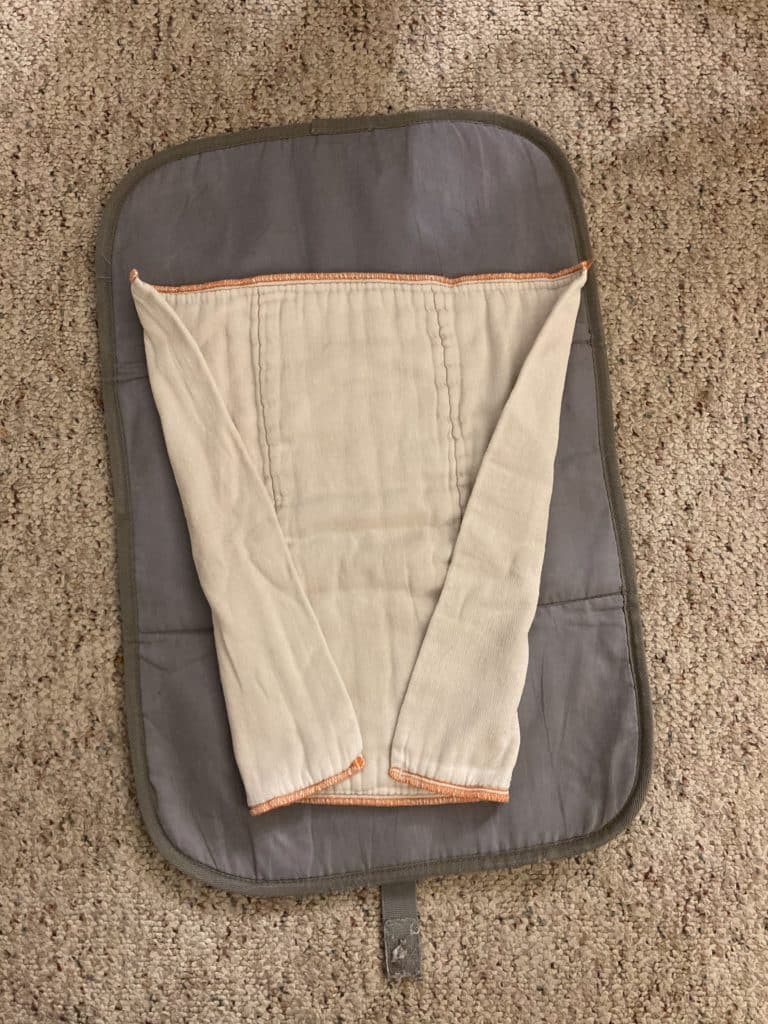

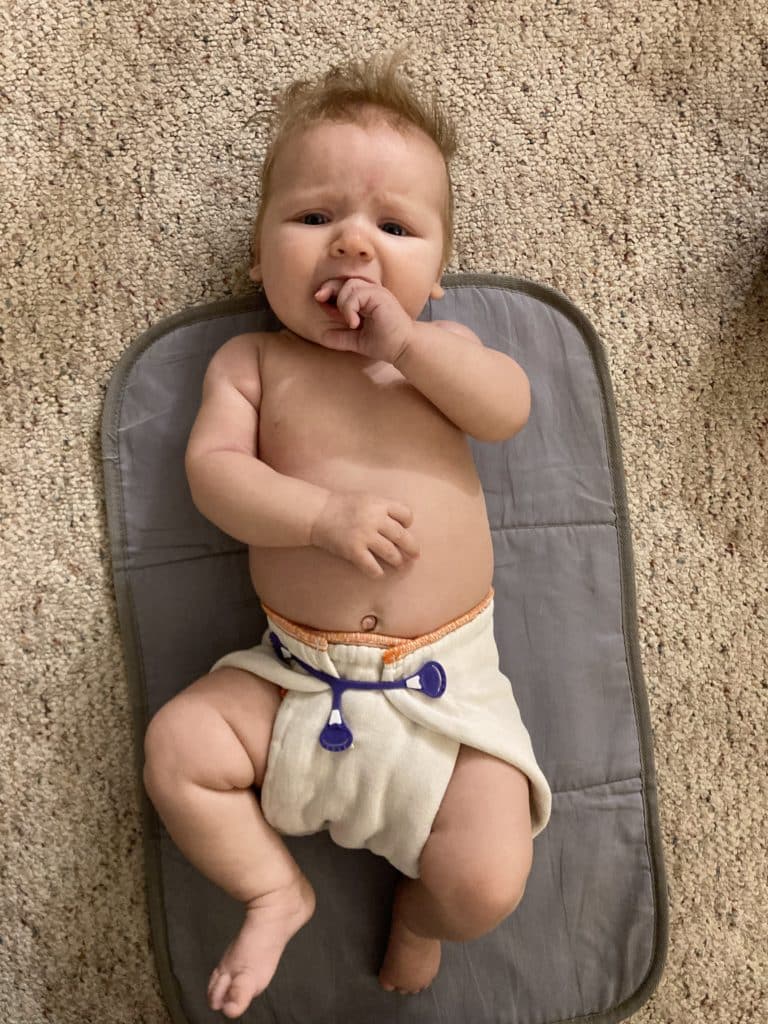
Prefold inserts come in various sizes, meaning you’ll need to size up as your baby moves from a newborn to a toddler. Certain tools are designed to make using prefolds easier, including Snappi Cloth diaper fasteners. These take the place of traditional diaper pins and eliminate the risk you’ll stab your baby while changing them.
When purchasing prefolds, make sure you get them pre-shrunk. Otherwise, a few trips through the washing machine may leave them irregularly sized and difficult to fold correctly.
In many ways, prefold diapers can be considered one of the most eco-friendly options in the world of cloth diapers. Since the inner absorbent layer is separate from the outer waterproof shell, you can ideally reuse the outer shell multiple times before putting it in the wash. Not only does this cut down on laundry, but it cuts down on the overall number of diapers you need to own since you only need one to two covers per day. And since the inserts are typically cotton or bamboo, you’ll also minimize the amount of synthetic plastics and nonrenewable resources used on your baby.
But, and maybe I’m the exception, you sacrifice a lot of convenience when using these diapers. I’ve been cloth diapering for two years and still can’t figure out how to fold a prefold so that it doesn’t leak within an hour. The multiple layers of fabric tend to be bulky and become a challenge to fit under standard-sized baby clothes. And, despite the claims to the contrary, I almost always have to toss the waterproof liner in the wash when I change a #2.
But on the positive side, you’re not out much money if you try out prefolds and decide they aren’t for you. These are easily the cheapest cloth diaper option, and the prefolds themselves are surprisingly versatile for other baby and household tasks. They make excellent burp cloths, dusting rags, and I’m sure many uses besides.
A waterproof cover must be paired with every prefold diaper. My brand of choice is the Flip one-size diaper cover. Each one-size cover comes with four adjustable sizing options, meaning it can fit kids from six pounds all the way to potty training age (or 35 pounds, whatever comes first). The Flip covers are made in the United States from 100% laminated polyester for a waterproof seal around the legs and back.


You’re meant to wrap each other around a prefold or other form of absorbant inner layer. Flip sells three hybrid insert types you can pair with the cover (stay-dry, organic, or disposable), and it’s also possible to use it over a standard single-use diaper to help prevent leaks. This adds the necessary waterproofing to keep everything contained. Ideally, the cover stays clean between changes, meaning you can use it multiple times throughout the day.
Spoiler alert: This rarely (never?) happens for me after dealing with baby poop, although you can probably get away with reusing the covers after pee.
Regarding use, these diapers are close to matching the convenience of all-in-ones and pocket diapers, so long as you always remember to keep both parts in your diaper bag. As with all forms of cloth diapers, you might have leaks around the seams if your baby isn’t the optimal size or you put the insert on slightly crooked.
Personally, I’m not a fan of this diapering style. Prefolds and covers are the diapers I reach for last. When dealing with a squirming infant, I find it challenging to put on a regular diaper, much less a diaper in two parts. The separate inner layer also seems prone to bunching, meaning that it doesn’t always offer full coverage. I’ve had the worst leaks with this style of diaper and personally would never consider using them overnight on evenings when I wanted to actually get some sleep. Not only that, most prefolds are made with water hungry conventional cotton, a textile that is often treated with pesticides.
However, I fully admit that these challenges may be due more to my own ineptness rather than problems with the Flip covers themselves. If you have great origami skills and a better handle on your baby during diaper changes, by all means give these a try. They’ll certainly save you money over other styles of cloth diapers—unless you pair them with the brand’s disposable inserts.

Smart Bottoms No Prep Organic Cloth Diaper 2.0
Highlights: Smart Bottoms cloth diapers ensure only organic materials come in contact with your baby’s skin. Just know it will take several wash cycles before they reach full functionality.
Materials: Organic cotton, hemp, and polyurethane laminate (outer cover).
Weight Range: 10-35 lbs.
Cost: $34 per diaper.
The Smart Bottoms Dream Diaper 2.0 is an all-in-one design that stands out from the competition in one fundamental way—the interior is made from certified organic cotton and hemp. More specifically, the diapers come with a cotton lining and an absorbent interior that’s 55% hemp and 100% organic cotton.
Founder Christy Malone started the company to give cloth diapering parents access to something she struggled to find—an organic cloth diapering system that was 100% made in the United States. As such, every aspect of management and manufacturing takes place domestically. Her goal was and continues to be to introduce caretakers to how easy, healthy, and inexpensive cloth diapering can be with the right equipment.

The all-in-one style of the Dream Diaper 2.0 means there’s no insert to pull out before washing, which is a welcome feature for anyone’s that accidentally stuck their fingers in baby poo while disassembling a cloth diaper. The outer layer is made from 100% PUL (polyurethane laminate) for durability and water resistance.
Thanks to its four-size settings, a Smart Bottoms diaper should work for babies from 10 lbs to over 35. It’s built with a snap-in insert and a reinforced pocket, which makes it possible to add inserts if you need extra absorbency. Remove the included insert to replace it with a Dream Diaper Overnight insert for additional protection (sold separately).
Note: It will take up to three washes for this diaper to reach full absorbency.


Another selling point? You can choose from tons of quirky prints for your cutie, including sushi rolls, camping scenes, doctor prints, doughnuts, dinosaurs, and breakfast foods.
Customer reviews show that many buyers are big fans of Smart Bottoms. One reviewer praised its slim fit and good absorbency level, sharing that they prevented leaks for her eight-month-old. Others appreciated the organic cotton that eased any concerns about toxin exposure and loved the range of cute, gender-neutral prints to choose from.


In a few cases, caretakers found the diapers too big for their babies, even when they fell within the size range and wore the diaper at its smallest setting. This led to a lot of gapping and leaks around the leg. Others found that they weren’t as absorbent as expected and tended to leak when used overnight—even with the overnight insert. Likewise, some users found the inserts to be weirdly shaped, as the long strip needed to be doubled over to fit within the diapers.
While some people shared that the price seemed too high for the diaper’s functionality, others noted that each diaper still looked brand new after being used by two kids. Even putting them in the dryer didn’t seem to wear them out fast.
My experience with these diapers was mediocre at best. I learned the lesson of “multiple washes before they work best” the hard way, as this diaper leaked dramatically within ten minutes of me first putting it on my child. That’s my own fault, as I hadn’t gone through the prerequisite three wash cycles that the company recommends. But let’s be honest—what busy mom has time for that? When you buy diapers, you want to be able to use them immediately.
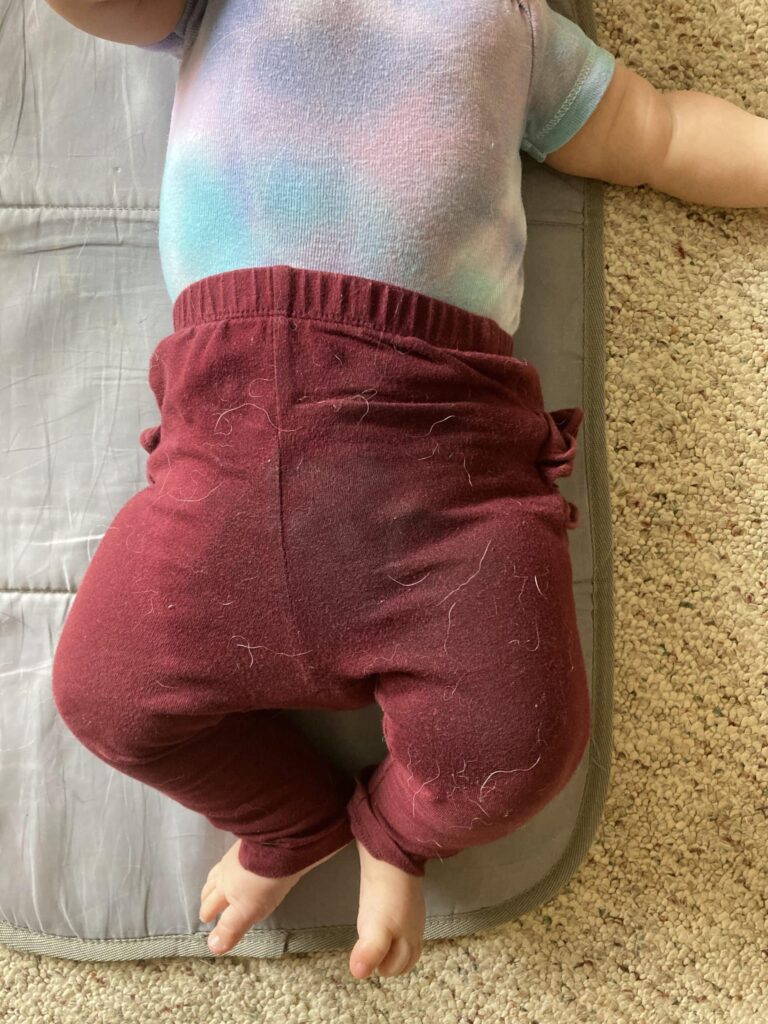
Likewise, I didn’t love the shiny exterior of these diapers. Despite the all-natural materials touching my baby’s skin, the waterproof shell was scratchy and almost cheap feeling. The skinny interior insert was somewhat hard to manage, and I found myself grabbing inserts from other brands to use with the diaper instead.
Overall, Smart Bottoms diapers did work better for my baby the longer I used them. She seemed comfortable in the diaper, and I could trust them for overnight use. But for me, they didn’t do enough to differentiate themselves from other brands to be worth the upcharge.
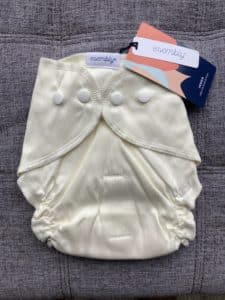
Esembly Certified Organic Cloth Diaper Inner Lining
Highlights: These organic cotton covers contain messes like champs to prevent leaks, but they fail at wicking moisture away from your baby’s bottom.
Materials: 100% organic cotton.
Weight Range: 18-35 lbs.
Cost: $42 per pack of three ($14 each).
For those who find prefolds appealing but don’t want to be responsible for folding, cloth diaper brand Esembly sells a two-in-one diaper system with 100% organic cotton. You’re meant to snap on this absorbent inner layer and then cover it with a waterproof lining (use Esembly’s or any brand of your choice).
Like with prefolds, this system is designed to help you get multiple wears out of each diaper, as you can reuse the outer cover repeatedly before tossing it in the wash. The main difference is that the inner lining comes diaper-shaped already with plenty of snaps for sizing, so you don’t need to deal with Snappis or diaper pins.
Esembly’s inner layers come in size one (7-17lbs) and size two (18-35lbs). Each is built with durable elastic around the waist and legs and an extra absorbent layer in the middle. The adjustable waist snaps ensure you get a secure fit no matter your baby’s size.


The diaper inserts are made from 100% organic cotton. As such, they tend to feel slightly damp when fully saturated because they don’t wick moisture away as well as synthetic materials. While this shouldn’t cause any issues for your baby, it’s a reminder that the diapers must be changed every few hours to limit wet exposure. Adding an Overnighter to the inside pocket as your baby grows will reduce any risk of discomfort and leakage at night.
Note: Esembly also sells Stay-Dry fleece liners that can be placed between the diaper and your baby’s skin to wick away moisture and reduce the risk of irritation.
According to reviews, Esembly customers are thrilled to add these inner diapers to their routine. Many praised how easy they are to use and wash, as their minimalist design means there aren’t many snaps or Velcro to fuss with. They thought the liners were surprisingly slim for a cloth diaper and didn’t add much bulk to your baby’s bottom.
Others loved that the diapers were made of all-natural materials and found they did an excellent job of keeping liquid off the waterproof cover so that it could be reused over the day.
However, some thought the design had functional problems. As one reviewer noted, the inner absorbing layer is only stitched in a few spots down the middle, which make the pad bunch and fold up under squirming legs. This can lead to messy leaks and the occasional blowout when poopy diapers aren’t changed in time.
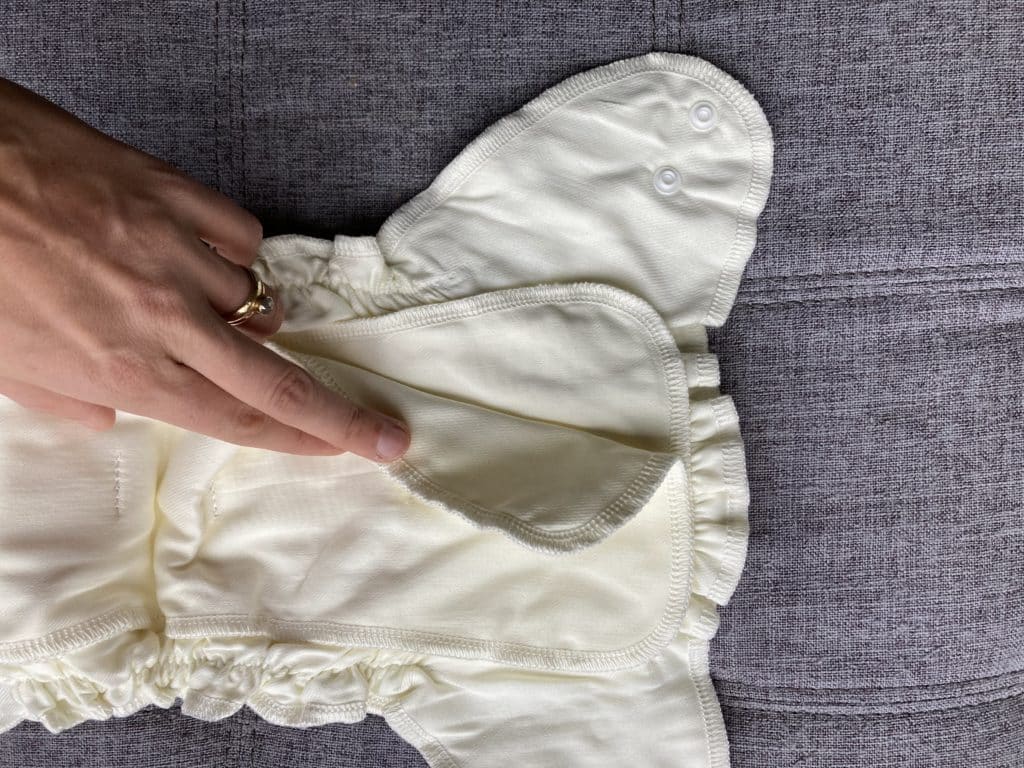
Others wished the diapers came in more sizes, as they struggled to get the right fit for their child, especially in the jump between sizes one and two.
I found that these diaper liners worked well. Impressively well. In fact, I never experienced a single leak throughout my testing period. It was easy to get a snug fit on my baby’s chunky legs, and the Flip covers I already owned covered the liner perfectly.
My biggest critique has to do with comfort. Every time I pulled these diapers off my baby, I was shocked by how drenched they were, and how wet her bum and legs felt. In fact, I ended up changing her more often than usual because she would cry soon after wetting herself. That’s due to a lack of microfiber lining that many other brands come with to prevent this irritation. (While Esembly sells fleece inserts to solve this problem, I didn’t personally test them).
I don’t want to overstate this issue. The diapers worked great, and I never had any problems with overnight use, as my baby slept soundly, even after peeing. However, constant exposure to that level of moisture on her bottom concerns me. If you choose this diaper style, I recommend also investing in the fleece liners or at least planning on more frequent diaper changes.

BumGenius Original
Highlights: Practical and well-made, BumGenius diapers rarely leak for me and still seem brand new after going through multiple babies.
Materials: Laminated polyester, 100% organic cotton.
Weight Range: 7-35 lbs.
Cost: $22 per diaper.
Designed by a mom who grew tired of lackluster options, BumGenius diapers are made in the United States and offer a lightweight pocket diaper for newborns on up.
The company got its start in 2005, and BumGenius diapers have been a bestselling cloth diaper brand since the beginning. They provide the classic pocket diaper design along with three rows of snaps for adjustable sizing. I can confirm that the same diapers have worked for my newborn and two-year-old alike.
The brand’s proprietary elastic was designed specifically for cloth diapers, meaning it’s soft on skin, water resistant, and made to withstand the rigors of the washing machine. Each diaper comes with two inserts—one that’s newborn-sized and another sized for babies three months and older.


In my experience, BumGenuis diapers are workhorses. While non-descript, they are durable, lightweight, and easy to layer with as many extra inserts as you need. While my entire collection of BumGenius diapers was used when I received them, most still look brand new even after dozens of trips through the washing machine.
The adjustable straps on the sides are easy to change at a moment’s notice, and I find these diapers actually seem less bulky when adjusted to their smallest measurements than any of its competitors. They truly work as desired for newborns on up, and nighttime leaks were relatively rare when using them—especially if you add an extra insert. The company notes that you can add the newborn insert in for extra security against leaks for larger children at night, and I’ve found that works great.

Customer reviews show that other BumGenius users agree with me. Many raved about how reliable the brand was and how well the diapers held up over time, even when used for multiple kids. These same users shared that BumGenius diapers were the only cloth brand they trusted to take out in public—no small thing considering the hassle of dealing with a leakthrough. Others loved the variety of colors available.
Today, BumGenius diapers are a little harder to find for sale online than the other brands listed here. Saying that, they are the brand I most recommend buying used, as my entire supply came to me that way, and they have been great for going on two years.

GroVia Buttah O.N.E.
Highlights: A soft exterior makes GroVia diapers feel like the height of luxury. However, their bulky design can make them harder to use with baby clothes.
Materials: Polyester microfiber, water-resistant polyester TPU, and cotton.
Weight Range: 10-35 lbs.
Cost: $23 per diaper.
GroVia diapers are another pocket design that claims to grow with your baby. The O.N.E. model stands for Outlast closure, No prep, and Easy to use.
The diapers come with two soaker pads each—one large and one small. Instead of a slick-feeling waterproof exterior, the diapers are encased with the brand’s proprietary laminated polyester velour. It’s meant to feel just like the name implies—like ‘buttah’.
Expect these diapers to work for babies from ten pounds to over 35. They are a big, beefy design that GroVia claims can hold in nighttime pee even if you forget to double up the liners. Each diaper features a two-method closure system. Choose to secure them with snaps, Velcro, or both. And, in a win for environmental sustainability, the company sells Velcro replacement kits for when yours starts showing wear.
Note: GroVia suggests you remove the Velcro before washing to prolong its lifespan.
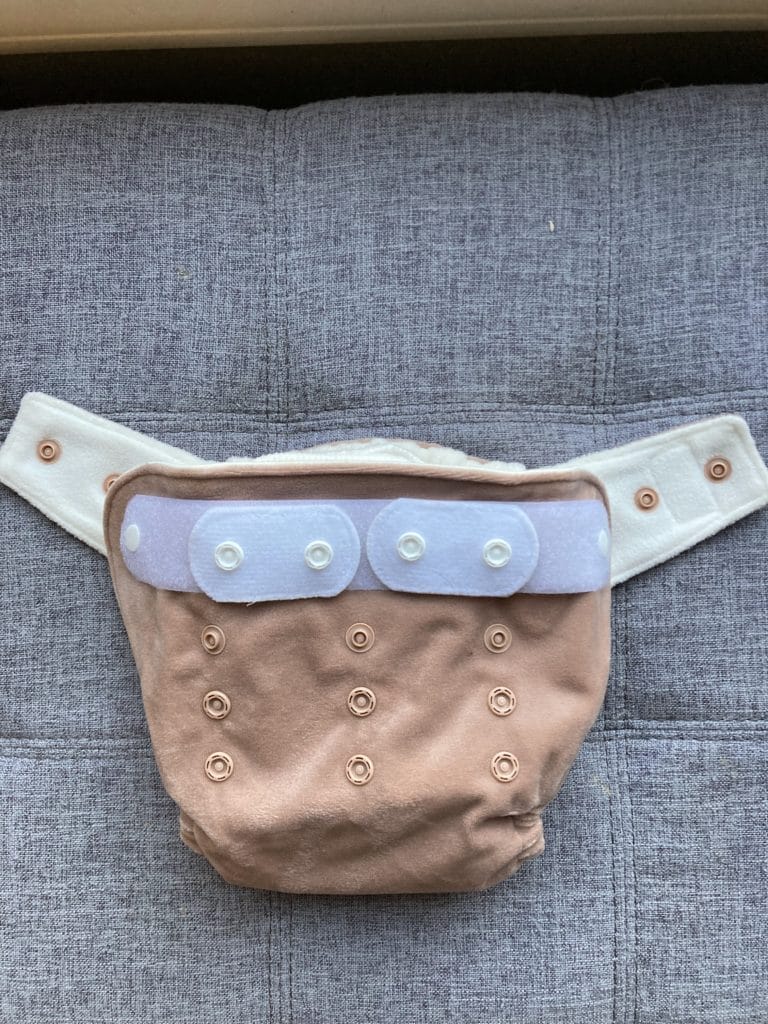

I want to love the GroVia diapers. Their monochrome coloring and velvety exterior makes them seem luxurious instead of cheesy like many cloth diapers. But here’s my main complaint—I can’t trust them not to leak. The first time I tried this diaper on my two-month-old, they leaked within an hour. This wasn’t a crazy blowout by any means. Rather, a small amount of pee caused some seeping right around the diaper seams and onto her pant legs. The problem was just bad enough that it required an immediate change, but the diaper itself was light enough after I took it off that I could tell there was hardly any pee actually in it. And for the record, my baby was well over the ten-pound minimum that GroVia recommends, so her size wasn’t the issue.
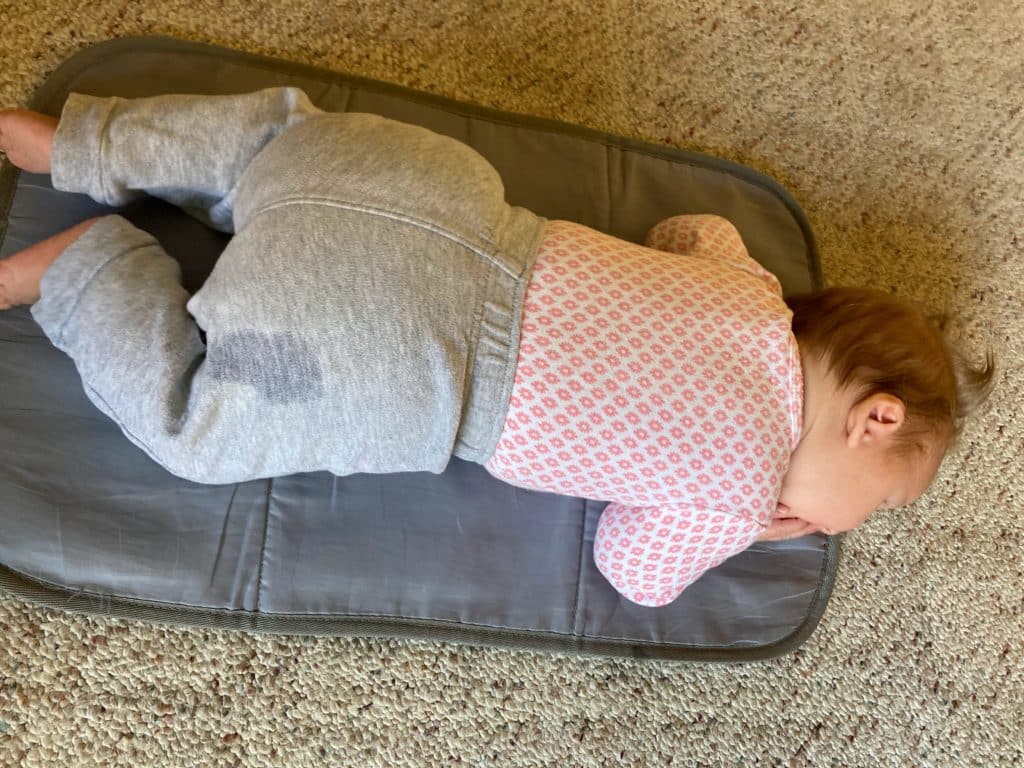
I used the diaper multiple more times over the next few weeks and experienced a similar level of leaking about one out of every four uses. The problem was worst at night, as the leakage caused my otherwise stellar sleeper to wake up crying in wet pjs twice. No amount of tightening or repositioning seemed to make much difference on my end, as I think the overall issue comes down to the size of the diaper’s leg holes leaving some gaps. I think these diapers will only improve as my baby grows, but for now, I’m left unimpressed with the number of outfit changes they necessitated.
And, while the double strap system sounds convenient, I mainly found it annoying. It’s hard to remember to remove the Velcro before washing, and there’s little worse than having to stick your hand into a bag of dirty diapers to take care of it once you remember again.

Bambino Mio Miosolo All-in-one
Highlights: Bambino diapers work well and offer a reliable option for cloth diapering your kid with all-in-ones.
Materials: Made from 100% polyester laminated to polyurethane, inner: 100% polyester, core: 85% polyester, 15% nylon.
Weight Range: One size fits all—8 lbs toddler.
Cost: $21 per diaper.
Another popular all-in-one cloth diaper, the Bambino Mio Miosolo is built with a polyester cover that’s OEKO-TEX Standard 100 certified. The absorbent inner lining comes in two layers is made from a blend of polyester and nylon. Both pieces are attached to the diaper and must be inserted into the pocket before use. This means you also need to pull it out again before throwing them in the wash, which can be gross for especially soiled diapers.


These diapers are designed to take a beating. The elastic legs prevent leaks and the adjustable snaps grow with your baby. Stylistically, you can choose from more than a dozen color options to ensure your baby has a designer look from the bottom up.

Of the brands I’ve used, I found the Bambino diapers to be the least memorable. That’s hardly a bad thing. The cartoon prints were cute but not flashy, and the diapers were relatively slim with minimal puffy padding. The polyester exterior didn’t have the plush factor of the GroVia diapers, but they fit well under clothes without adding tons of bulk.
After a few weeks of testing, I did experience occasional leakage. It seems that these diapers hold up well after the initial potty session, but they are prone to leaking the longer you leave them unchanged on your child. I found I couldn’t rely on them for longer than three hours at a time, making them a no go for overnight use.
The Velcro along the front looks cute when new, but I suspect it will wear down fast and make these diapers look a little bedraggled after several trips through the washing machine. And unfortunately, the company doesn’t offer any replacements.

Charlie Banana Baby Fleece Reusable
Highlights: Plush and pricey, Charlie Banana diapers are worth the splurge if you’re committed to cloth diapering.
Materials: Cloth Diaper: polyester, polyurethane. Reusable Insert: polyester, biconstituent fiber (80% polyester, 20% nylon).
Weight Range: 0-36 months.
Cost: $26.99 per diaper and two inserts.
Charlie Banana pocket diapers consist of a polyester shell lined with ultra-soft fleece. They are certified climate neutral, OEKO-TEX certified, and come in a wide variety of patterns. Another plus—the company has committed 1% of its sales to supporting environmental causes.
Their one-size design means you can expect them to work from the trip home from the hospital until age three, although they might be more prone to leaks when wrapped around smaller bums. Each pocket diaper has an array of snaps to shrink or expand it based on the baby’s size. Expect it to get bunchier when used at the smallest setting.


Charlie Banana diapers strike a balance of being both cute and painless for parents to use. Upon pulling it out of the packaging, my first thought was it felt like a waste to use something so pretty for baby poo. The interior fleece is by far the softest I’ve tested, and the diapers cinch up well along little legs for a tight fit. And despite their apparent plushness, they provide a relatively slim profile when actually on your baby–meaning you can assume they will still fit into bottoms sized appropriately for their age.
It remains to be seen how well this fleece layer will wear over time, as it feels like it might have a tendency to get matted. Keeping the diapers out of the dryer should minimize this risk, although the company suggests that tumble drying on low is ok.
The adjustable leg straps have lots of stretch, which makes me feel reasonably confident they can prevent leaks in all circumstances. Trial runs of using them overnight and while riding in a baby carrier showed they definitely seem up to the task.

While I appreciated that the diapers came with multiple removable inserts, I personally never need to use more than one at a time. A single layer is enough to keep my little one dry overnight. However, multiple inserts may become more useful as your child grows, especially for overnight use.
Another positive: these diapers were some of the fastest I own to line dry.
The biggest drawback I experienced with these diapers was the price. At $26-$30 per diaper, you’ll pay more to own a whole set than the other brands. However, their lack of leaking might mean you’ll go through fewer outfit changes each day, so it’s definitely possible that you can offset the costs in other ways.